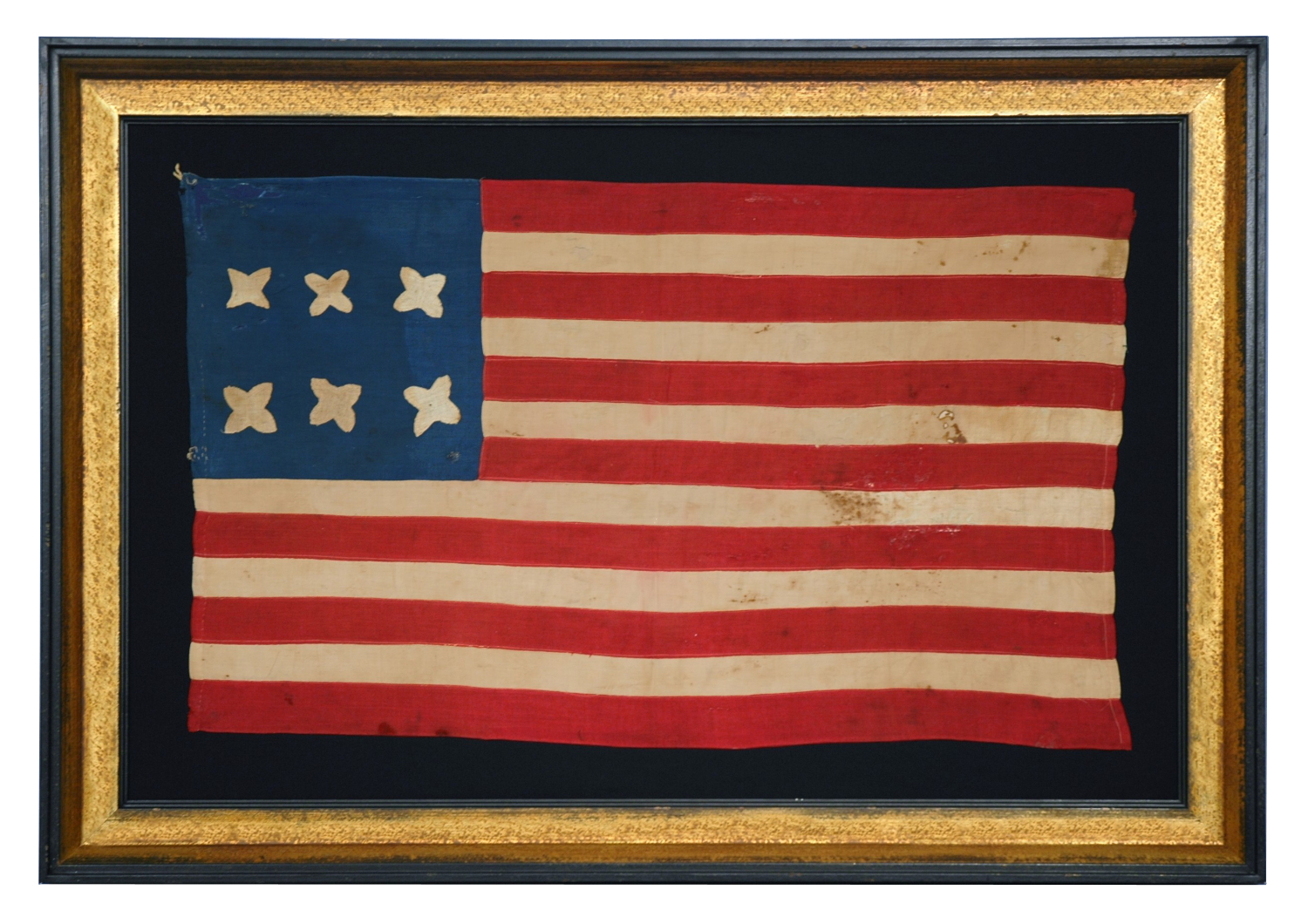
| |
EXTREMELY RARE 6 STAR LOUISIANA SECESSIONIST VERSION OF THE STARS & STRIPES, ONE OF TWO KNOWN, AN EARLY WAR CONFEDERATE FLAG, CIRCA 1861 |
|
| Available: |
Sold |
| Frame Size (H x L): |
33" x 48" |
| Flag Size (H x L): |
22" x 37.5" |
|
| Description....: |
|
EXTREMELY RARE 6 STAR LOUISIANA SECESSIONIST VERSION OF THE STARS & STRIPES, ONE OF TWO KNOWN, AN EARLY WAR CONFEDERATE FLAG, CIRCA 1861:
Before the adoption of the first national flag design (a.k.a. the Stars & Bars) on March 4, 1861, there was both creativity and confusion surrounding what form the new flag of the Confederacy should take. There was little clarity, but there was both state-associated patriotism and more generalized southern affection. Such sentiments were accompanied by the fact that many southerners were hesitant to abandon the Stars & Stripes, preferring instead some adaptation of it that retained the basic characteristics, but excluded those stars that represented abolitionist states. Sometimes these southern sympathizer flags contained a number of stripes reflected the Confederacy, and sometimes they included the full complement of 13.
This particular flag, found in the possession of a New Orleans family in 2006, retains the 13 stripes of an official American national flag, yet substitutes a count of just 6 stars in its blue canton to represent Louisiana, the sixth state to secede from the Union. The flag is testament not only to the individuality in homemade pre-secession designs, but also to the outstanding folk qualities sometimes present in early American flags.
Notice how the four-pointed stars vary greatly in shape and vertical orientation. They are single-appliquéd, meaning that they are applied to one side of the flag and cut-outs are made behind, so that one star can be viewed on both sides. The method almost always resulted in stars that exhibit greater irregularity in shape and are thus more interesting. In this regard the flag is simply outstanding from a visual stand point. In addition, flags with four-pointed stars are exceptionally rare and highly sought after by advanced collectors. Only a small handful exist with this trait.
Louisiana adopted its ordinance of secession at the state capital of Baton Rouge on January 26, 1861, followed just five days later by Texas on February 1st. Three days later, on February 4th, delegates from the seven states met in Montgomery, AL to write the Confederate constitution, which was ratified on March 11th This is why Louisiana and balance total of seven states that had thus far joined the Confederacy are said to have technically left the Union together in what is called “the first wave of secession.” The remaining four states that officially seceded did not leave the Union until the period between April and May of the same year, following the April 12th attack on Ft. Sumter that signified the formal outbreak of war.
Six star flags like this one are so rare that only two are known. One 6-star, Stars & Stripes version resides in the collection of the Milwaukee Public Museum. That example has five pointed stars.
Another 6-star, Louisiana-associated, confederate prototype exists, but it is an adaptation of the French flag, turned on end so the blue, white and red (rouge) bars are horizontal. On that flag, the stars placed in the upper left corner in two backwards-facing crescents. Four of the stars fall within the top stripe, and the other two in the stripe below it.
Construction: The flag is constructed entirely of cotton bunting that has been pieced with a treadle machine. Even the stars and treadle-sewn, which is very unusual, yet far from unheard of in the making of Civil War flags. They are the exception, but I have owned several period examples.
Though the 1855, mass-marketed sewing machine was used liberally in the piecing of stripes during the Civil War period, seamstresses evidently found it very difficult to turn the flag, pump the treadle with their foot, and set out upon the advanced task of appliquéing stars. Such work is difficult enough by hand that most quilters don’t attempt it today. In the 1860’s, however, the general population’s sewing skills were far greater and, for the time being, it made much more sense to hand-sew stars. Proof of this statement actually lies in the construction of these particular four-pointed stars, which have child-like irregularity in their size, shape, and placement. There is little doubt in my mind that this was partly a byproduct the machine stitching. Though it is not out of the realm of possibility that the stars were sewn by a child, it is likely that even the more advanced sewer would be untrained in using a machine to appliqué stars to the blue canton.
Mounting: the flag has been hand-stitched to 100% silk organza for support, then to a background of 100% cotton twill, black in color. The cotton was washed to reduce excess dye. An acid-free agent was added to the wash to further set the dye and the fabric was heat treated for the same purpose. The flag was ten placed in a black-painted, hand-gilded and distressed Italian molding. The front is U.V. protective acrylic. |
|
|
|
| Collector Level: |
Advanced Collectors and the Person with Everything |
|
| Flag Type: |
Sewn flag |
|
| Star Count: |
Other |
|
| Earliest Date of Origin: |
1861 |
|
| Latest Date of Origin: |
1861 |
|
| State/Affiliation: |
Louisiana |
|
| War Association: |
1861-1865 Civil War |
|
| Price: |
SOLD |
|
| |
Views: 8141 |
|
|
|

